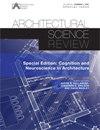风对带有护墙的大型低斜山墙屋顶建筑产生的压力
IF 1.8
3区 艺术学
0 ARCHITECTURE
引用次数: 0
摘要
本文通过实验研究了不同高度的护墙如何改变大纵横比低坡山墙屋顶建筑周围的流动模式。我们研究了现有方法的优点和挑战,并利用开放式喷气风试验段来准确模拟真实世界的大气边界层条件。一个低层建筑模型安装了不同高度的实心护墙,并在一项比较研究中进行了测试,以了解它们对屋顶压力的影响。该研究将标准方法与实验结果进行了比较,并建议改进风区和压力系数。与其他尺寸相比,建筑高度14%的女儿墙在降低平均、峰值和面积平均风荷载方面最有效。然而,标准规定低估了构件和覆层设计的屋顶压力。本文章由计算机程序翻译,如有差异,请以英文原文为准。
Wind induced pressures on a large low-sloped gable roof building with parapet
This paper experimentally investigates how parapets with varying heights can alter the flow pattern around a large aspect-ratio low-sloped gable roof building. We examine the benefits and challenges of existing methods and utilize an open-jet wind test section, to accurately simulate real-world atmospheric boundary layer conditions. A model of a low-rise building was fitted with solid parapets of varying heights and tested in a comparative study to understand their impact on roof pressures. The study compares the standard approach to the experimental results and suggests improvements to wind zones and pressure coefficients. The parapet of fourteen percent of the building height is the most efficient at reducing mean, peak, and area-averaged wind loads compared to other sizes. However, the standard provisions underestimate roof pressures for components and cladding design.
求助全文
通过发布文献求助,成功后即可免费获取论文全文。
去求助
来源期刊

Architectural Science Review
ARCHITECTURE-
CiteScore
4.80
自引率
8.70%
发文量
34
期刊介绍:
Founded at the University of Sydney in 1958 by Professor Henry Cowan to promote continued professional development, Architectural Science Review presents a balanced collection of papers on a wide range of topics. From its first issue over 50 years ago the journal documents the profession’s interest in environmental issues, covering topics such as thermal comfort, lighting, and sustainable architecture, contributing to this extensive field of knowledge by seeking papers from a broad geographical area. The journal is supported by an international editorial advisory board of the leading international academics and its reputation has increased globally with individual and institutional subscribers and contributors from around the world. As a result, Architectural Science Review continues to be recognised as not only one of the first, but the leading journal devoted to architectural science, technology and the built environment. Architectural Science Review publishes original research papers, shorter research notes, and abstracts of PhD dissertations and theses in all areas of architectural science including: -building science and technology -environmental sustainability -structures and materials -audio and acoustics -illumination -thermal systems -building physics -building services -building climatology -building economics -ergonomics -history and theory of architectural science -the social sciences of architecture
 求助内容:
求助内容: 应助结果提醒方式:
应助结果提醒方式:


